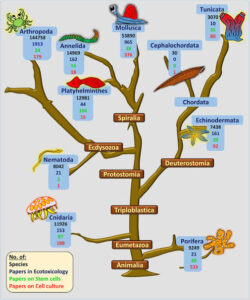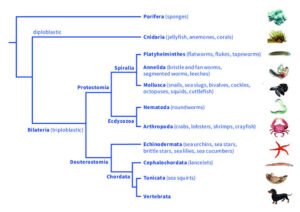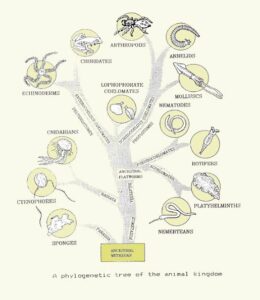Back to: ZOOLOGY 200 Level
WELCOME TO CLASS
Today, we’ll be examining a very important topic in Zoology—the evolutionary relationships among invertebrate phyla. Understanding how different groups of invertebrates are related helps us to trace their origins, similarities, and how they have changed over time. This lesson connects what we see today with the long journey of life on Earth.
Evolutionary Relationships Among Invertebrate Phyla
What are invertebrate phyla?
Invertebrates are animals without backbones, and they make up more than 95% of all known animal species. They are grouped into different phyla (the plural of phylum), based on their body structure, development, and functions. Some examples include Annelida (earthworms), Arthropoda (insects, crabs), Mollusca (snails), and Cnidaria (jellyfish).

Each phylum has distinct features, but some are more closely related to each other based on shared characteristics, which tell us about their common ancestors.
Shared features and body plans
Scientists study features like symmetry (bilateral or radial), the presence of a body cavity (coelom), segmentation, and patterns of development to determine evolutionary relationships.
For example, both Annelids (segmented worms) and Arthropods (insects, spiders) have segmented bodies, suggesting they may have evolved from a common segmented ancestor. Likewise, Molluscs and Annelids both show evidence of having similar developmental patterns, indicating a closer evolutionary link.
Use of molecular data
In modern times, scientists also use genetic information (DNA and RNA) to understand evolutionary relationships. This molecular data often confirms what was suspected from physical features, but sometimes it reveals surprising connections.

For instance, although Arthropods and Annelids both have segmented bodies, genetic studies show Arthropods are more closely related to nematodes than previously thought. These studies have helped build more accurate evolutionary trees.
Phylogenetic trees and relationships
A phylogenetic tree is like a family tree for animals, showing how different phyla branched off from common ancestors. The base of the tree represents the earliest life forms, and the branches show how different phyla evolved and diversified over time.
Simple animals like sponges (Phylum Porifera) are placed near the base, while more complex animals like insects (Arthropoda) and molluscs are on higher branches. This tree helps us understand not just who is related to whom, but also how complexity in body structure evolved.

Summary
- Invertebrate phyla are classified based on body structure and function.
- Evolutionary relationships are determined by features like symmetry, segmentation, and development.
- Molecular data (DNA) helps confirm or refine these relationships.
- Phylogenetic trees show how different phyla evolved from common ancestors.
Evaluation
- Name three features used to determine evolutionary relationships among invertebrates.
- What is a phylogenetic tree and what does it represent?
- Which two invertebrate phyla show segmentation and what does this suggest?
- How does molecular data help in understanding invertebrate evolution?
You’re gaining a deeper understanding of the big picture of life. Each invertebrate phylum tells a unique story of survival, change, and connection. Keep up the great effort—Afrilearn is proud to support your learning journey every step of the way!
